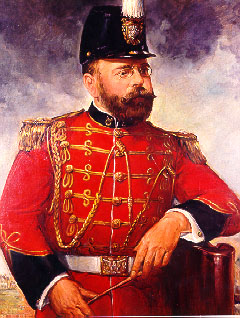SOUSA-JOHN
JOHN PHILIP SOUSA

SGTMAJ/LCDR

AMERICAN MARCH KING
John Philip Sousa was an American composer and conductor, known primarily for American military and patriotic marches, and often called the “American March King.” Among his best known marches are “Semper Fidelis” (1888 - Official march of the Marine Corps) and “The Stars and Stripes Forever” (1896 - Official march of the United States).
Sousa was born on November 6, 1854, in Washington, D.C., the third of ten children. He started his music education by playing the violin at the age of six and during his childhood studied voice, piano and a variety of other instruments. On June 9, 1868, when Sousa was age-13, his father, a trombonist in the Marine Band, enlisted him as a “boy” apprentice musician in the U.S. Marine Corps to keep him from joining a circus band. Sousa reenlisted on July 8, 1872, and served in the band until 1875 when he left the Marine Corps at the age of 20. At this time, Sousa learned how to conduct and rejoined the Marine Band in 1880 as its conductor. He served with the rank of Sergeant Major and received a salary of $83 per month as “leader of the band.” Under his leadership, the Marine Band became the premier military band in the United States. On July 30, 1892, he conducted a farewell concert at the White House and was discharged from the Marine Corps the following day to organize his own band with which he toured Europe and Australia. During this time Sousa also developed the sousaphone, a large brass instrument similar to the tuba. By this time Sousa had become nationally famous because of his musical endeavors.
At the outbreak of World War One, Sousa was commissioned as a Lieutenant in the Naval Reserve, returned to active duty, and led the Naval Reserve Band at the Naval Station in Great Lakes, Illinois. While in the Navy, Sousa was paid only a token salary of $1 per month as he donated the rest of his salary to the Sailors' and Marines' Relief Fund. He was discharged from active duty after the war’s end in November 1918. He returned to conducting his own band but continued to wear his naval uniform for many of his concerts and other public appearances. Although he was subsequently promoted to the rank of Lieutenant Commander in the Naval Reserve, he never again returned to active duty.
John Philip Sousa died on March 6, 1932, at Reading, Pennsylvania, where he was scheduled to conduct a band concert. His body was brought to his native Washington, D.C., to lie in state in the Band Hall at the Marine Barracks. Four days later, two companies of Marines and Sailors, the Marine Band, and honorary pall-bearers from the Army, Navy, and Marine Corps headed the funeral cortege from the Marine Barracks to the Congressional Cemetery in Washington where Sousa was buried. His memorial marker there carries the inscription: LTCOM – USNR.
During World War II, in his honor, the Liberty ship SS John Philip Sousa was commissioned. The ship’s bell is still used by the Marine Band in concert. During his career, Sousa published 137 marches. He also reportedly wrote 15 operettas, 5 overtures, 11 suites and numerous other arrangements of symphonic works.
Submitted by CDR Roy A. Mosteller, USNR (Ret)


